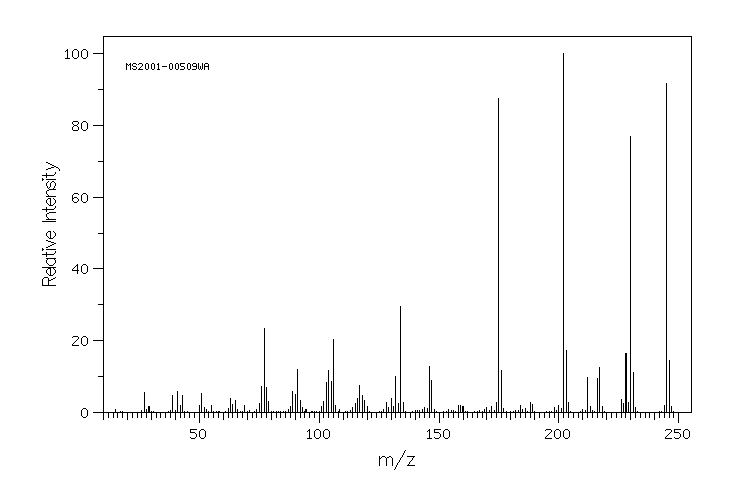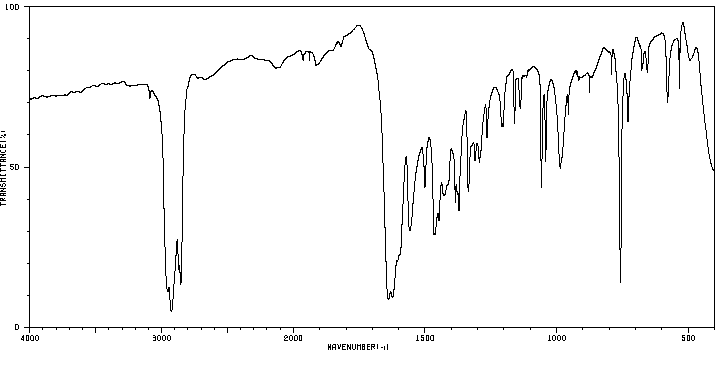3-butyryl-4-hydroxy-1-methyl-1H-quinolin-2-one | 73281-62-6
中文名称
——
中文别名
——
英文名称
3-butyryl-4-hydroxy-1-methyl-1H-quinolin-2-one
英文别名
3-Butanoyl-4-hydroxy-1-methylquinolin-2-one
CAS
73281-62-6
化学式
C14H15NO3
mdl
——
分子量
245.278
InChiKey
SSZYERFDXKDDTM-UHFFFAOYSA-N
BEILSTEIN
——
EINECS
——
-
物化性质
-
计算性质
-
ADMET
-
安全信息
-
SDS
-
制备方法与用途
-
上下游信息
-
文献信息
-
表征谱图
-
同类化合物
-
相关功能分类
-
相关结构分类
计算性质
-
辛醇/水分配系数(LogP):2.2
-
重原子数:18
-
可旋转键数:3
-
环数:2.0
-
sp3杂化的碳原子比例:0.29
-
拓扑面积:57.6
-
氢给体数:1
-
氢受体数:3
上下游信息
-
上游原料
中文名称 英文名称 CAS号 化学式 分子量 4-羟基-N-甲基-2-喹啉 4-hydroxy-1-methyl-2(1H)-quinolone 1677-46-9 C10H9NO2 175.187 -
下游产品
中文名称 英文名称 CAS号 化学式 分子量 —— 3-butyl-4-hydroxy-1-methylquinolin-2(1H)-one 100717-76-8 C14H17NO2 231.294
反应信息
-
作为反应物:描述:3-butyryl-4-hydroxy-1-methyl-1H-quinolin-2-one 在 盐酸 、 锌 作用下, 以 乙醇 、 溶剂黄146 为溶剂, 反应 0.08h, 以76%的产率得到3-butyl-4-hydroxy-1-methylquinolin-2(1H)-one参考文献:名称:一种锌-乙酸-盐酸还原酰基取代的杂环1,3-二羰基化合物为烷基衍生物的简单有效的方法。摘要:3-酰基-4-羟基-2(1H)-喹诺酮(1a–k)以良好的收率(66–97%)降低为3-烷基-4-羟基-2(1H)-喹啉酮(2a–k)使用醋酸/盐酸中的锌粉(粒度<45μm)。该方法可转化为3-乙酰基-4-羟基香豆素(1l),3-乙酰基-4-羟基-2-吡喃酮(3a)和3-乙酰基-4-羟基-2(1H)-吡啶酮(3b)),分别产生3-乙基衍生物2l,4a和4b。DOI:10.1016/0040-4020(95)00733-o
-
作为产物:描述:在 sodium hydroxide 作用下, 以 乙二醇 为溶剂, 反应 1.5h, 以92%的产率得到3-butyryl-4-hydroxy-1-methyl-1H-quinolin-2-one参考文献:名称:Syntheses of 3-Acyl-4-hydroxy-2(1H)quinolones摘要:3-Acyl-4-hydroxy-2(1H)-quinolones 5 are obtained by hydrolytic ring opening and subsequent decarboxylation from the corresponding pyrano[3,2-c]quinolin-2,5(6H)-diones 4, which in turn are easily obtained from 1:2 condensation of anilines 1 with diethyl malonate 2a or 1:1 condensation of diethyl alkyl- or arylmalonates 2b-e with 4-hydroxy-2(1H)-quinolones 3. Nitropyranoquinolinediones 6 furnish after ringopening 3-nitroacetyl-4-hydroxy-2(1H)quinolones 8. Pyranoquinolines 7 and 9 with acetyl- or aminosubstituents are hydrolyzed during basic ringopening to yield 5.DOI:10.1002/prac.19943360707
表征谱图
-
氢谱1HNMR
-
质谱MS
-
碳谱13CNMR
-
红外IR
-
拉曼Raman
-
峰位数据
-
峰位匹配
-
表征信息
同类化合物
(S)-4-(叔丁基)-2-(喹啉-2-基)-4,5-二氢噁唑
(SP-4-1)-二氯双(喹啉)-钯
(E)-2-氰基-3-[5-(2,5-二氯苯基)呋喃-2-基]-N-喹啉-8-基丙-2-烯酰胺
(8α,9S)-(+)-9-氨基-七氢呋喃-6''-醇,值90%
(6,7-二甲氧基-4-(3,4,5-三甲氧基苯基)喹啉)
(1-羟基-5-硝基-8-氧代-8,8-dihydroquinolinium)
黄尿酸 8-甲基醚
麻保沙星EP杂质D
麻保沙星EP杂质B
麻保沙星EP杂质A
麦角腈甲磺酸盐
麦角腈
麦角灵
麦皮星酮
麦特氧特
高铁试剂
高氯酸3-苯基[1,3]噻唑并[3,2-f]5-氮杂菲-4-正离子
马波沙星EP杂质F
马波沙星
马来酸茚达特罗杂质
马来酸茚达特罗
马来酸维吖啶
马来酸来那替尼
马来酸四甲基铵
香草木宁碱
颜料红R-122
颜料红210
颜料红
顺式-苯并(f)喹啉-7,8-二醇-9,10-环氧化物
顺式-(alphaR)-N-(4-氯苯基)-4-(6-氟-4-喹啉基)-alpha-甲基环己烷乙酰胺
非那沙星
非那沙星
青花椒碱
青色素863
雷西莫特
隐花青
阿莫地喹-d10
阿莫地喹
阿莫吡喹N-氧化物
阿美帕利
阿米诺喹
阿立哌唑溴代杂质
阿立哌唑杂质B
阿立哌唑杂质38
阿立哌唑杂质1750
阿立哌唑杂质13
阿立哌唑杂质
阿立哌唑杂质
阿尔马尔
阿加曲班杂质43








